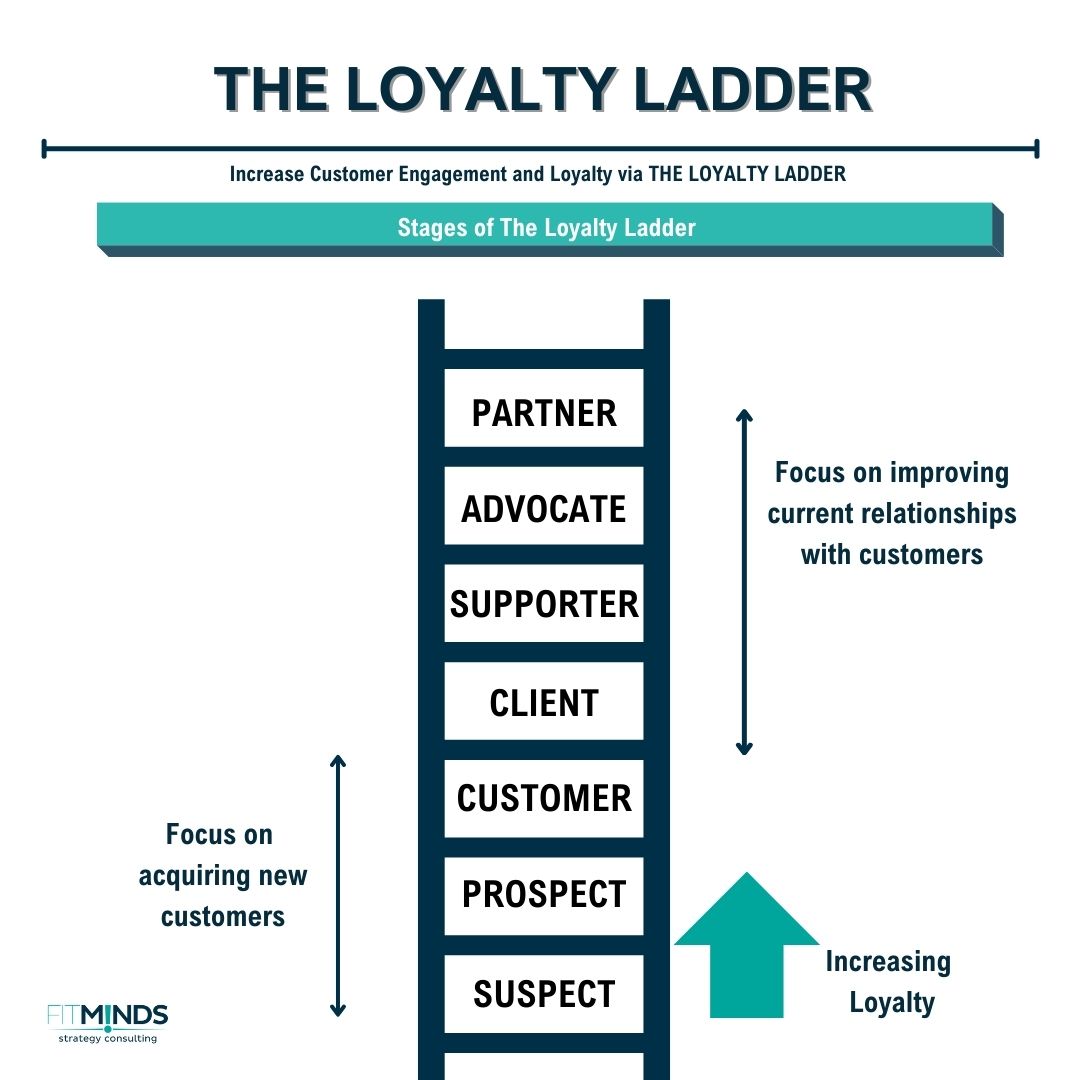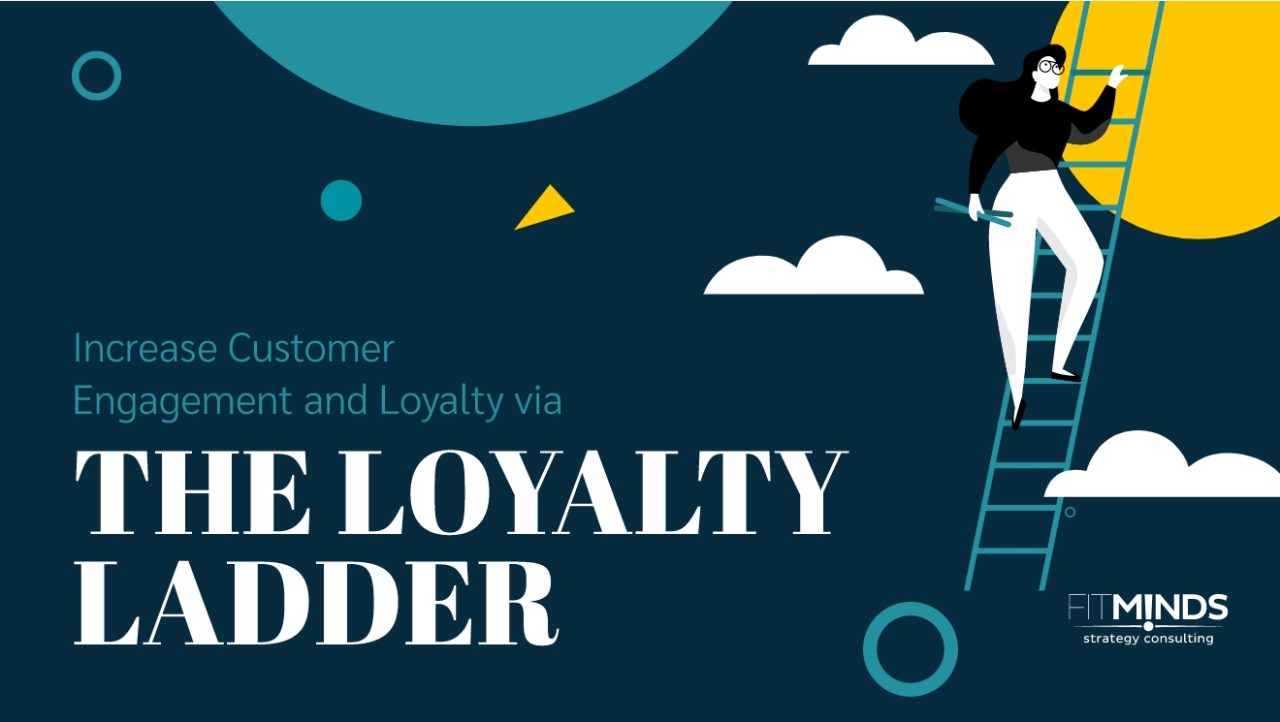The Loyalty Ladder is a marketing concept that illustrates the progression of customers through various stages of loyalty to a brand or business. It helps businesses understand and categorize customers based on their level of commitment and engagement.
Main Benefits of The Loyalty Ladder
By using The Loyalty Ladder, businesses can nurture customer relationships and increase the average customer’s lifetime value. It provides a structured approach to building long-term relationships.
The Loyalty Ladder helps:
- to enhance products, services, and customer support, ultimately resulting in an improved overall customer experience,
- to create effective marketing campaigns by addressing the customer’s needs and desires at each stage of the journey,
- to determine areas for improvement and create targeted messaging,
- to focus on building a strong relationship with prospects and increasing retention rates.
Explanation of The Loyalty Ladder
A loyalty ladder represents the stages of customer loyalty, ranging from initial awareness to brand advocacy. Each step on the ladder signifies a deeper level of engagement and commitment from the customer.
While the exact number of stages may vary, a common framework includes the following stages:
- Suspect
This is the initial stage where individuals or entities are identified as potential targets. At this stage, there hasn’t been any direct engagement or interaction yet. Suspects may potentially need the product or service, and they are likely candidates for it. Awareness is often generated through various marketing channels, such as advertising campaigns or positive word-of-mouth referrals.
- Prospect
A prospect is someone who takes the first step by making an inquiry or seeking additional information. At this stage, marketing efforts are focused on nurturing and developing this interest. This phase acts as a bridge between the initial awareness of the brand and the active consideration of it, laying the foundation for a meaningful and mutually beneficial relationship.
- Customer
At this stage, individuals or entities have completed at least one transaction, gaining firsthand experience with the product or service. The goal is to ensure a positive encounter, not only for a one-time transaction but also to establish a foundation for a lasting relationship. The initial purchase marks the start of the customer journey, shifting the focus toward fostering satisfaction, loyalty, and the potential for repeat business.
- Client
The term “client” typically suggests a more enduring and deeper relationship compared to a customer. Clients commonly interact with the business regularly and may benefit from personalized services or attention. This loyal customer often engages in loyalty programs, establishing a meaningful connection with the business, indicative of a deeper and ongoing relationship based on trust and mutual understanding.
5. Supporter
Supporters represent a stage where customers or clients transcend routine transactions, actively endorsing and appreciating the brand. Supporters engage in loyalty programs, offer positive reviews, and participate in the brand’s content or community. At this stage, customers exhibit high loyalty, though they haven’t reached advocacy yet. During this phase, customers demonstrate a readiness to explore additional offerings from your brand.
- Advocate
Advocates are passionate supporters who actively promote the brand to others. They go beyond personal satisfaction and actively encourage their network to engage with the brand. With a foundation of high trust and loyalty, advocates often contribute to positive word-of-mouth marketing and may participate in referral programs.
- Partner
In some loyalty ladder models, the highest stage involves a partnership between the brand and the customer. This could include exclusive access, special privileges, or involvement in co-creation. At this level, the relationship extends beyond traditional customer-brand dynamics, fostering a mutually beneficial and highly engaged alliance.
Understanding the diverse needs and preferences of customers at various stages allows companies to customize and adapt their marketing strategies accordingly. Recognizing that customer journeys are not always linear and individuals may move back and forth between stages emphasizes the importance of flexibility in approach.
Effectively implementing a loyalty ladder requires continual assessment of program effectiveness. Making adjustments based on customer feedback is crucial for maintaining and enhancing customer relationships.
How to Apply The Loyalty Ladder
To apply The Loyalty Ladder to your business, FITMINDS is providing an adoption of the model that fits your company and your company’s needs. By using The Loyalty Ladder, businesses can increase customer engagement and loyalty.
Contact us to get more information or discover your probable personalized roadmap for The Loyalty Ladder.
Additional Tips and Readings
- You can learn more about customer decisions with the Simonson & Rosen’s Influence Mix.
- To increase your customer loyalty and lifetime value, you can check RFM Analysis & Segmentation.
- To learn more about customer behavior, you can read our The Product Diffusion Curve
- To read more about the creation of habitual behaviors, you can check The Hook Model of Behavioral Design
Contact us to create effective marketing strategies via The Loyalty Ladder.



13 comments
Pingback: cheapest buy enclomiphene no prescription online
Pingback: kamagra pas cher à vendre sans prescription requise
Pingback: Next day fedex shipping for androxal
Pingback: how to order dutasteride price by pharmacy
Pingback: cheap flexeril cyclobenzaprine generic lowest price
Pingback: cheapest buy fildena purchase online from india
Pingback: order gabapentin lowest price viagra
Pingback: order staxyn purchase discount
Pingback: Cheap itraconazole no script
Pingback: cheap avodart purchase tablets
Pingback: get rifaximin purchase in canada
Pingback: purchase xifaxan generic extended release
Pingback: kamagra bez lékařského předpisu v kanadě
Comments are closed.